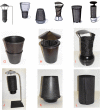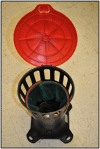Design and Testing of Novel Lethal Ovitrap to Reduce Populations of Aedes Mosquitoes: Community-Based Participatory Research between Industry, Academia and Communities in Peru and Thailand
- PMID: 27532497
- PMCID: PMC4988764
- DOI: 10.1371/journal.pone.0160386
Design and Testing of Novel Lethal Ovitrap to Reduce Populations of Aedes Mosquitoes: Community-Based Participatory Research between Industry, Academia and Communities in Peru and Thailand
Abstract
Background: Dengue virus (and Chikungunya and Zika viruses) is transmitted by Aedes aegypti and Aedes albopictus mosquitoes and causes considerable human morbidity and mortality. As there is currently no vaccine or chemoprophylaxis to protect people from dengue virus infection, vector control is the only viable option for disease prevention. The purpose of this paper is to illustrate the design and placement process for an attractive lethal ovitrap to reduce vector populations and to describe lessons learned in the development of the trap.
Methods: This study was conducted in 2010 in Iquitos, Peru and Lopburi Province, Thailand and used an iterative community-based participatory approach to adjust design specifications of the trap, based on community members' perceptions and feedback, entomological findings in the lab, and design and research team observations. Multiple focus group discussions (FGD) were held over a 6 month period, stratified by age, sex and motherhood status, to inform the design process. Trap testing transitioned from the lab to within households.
Results: Through an iterative process of working with specifications from the research team, findings from the laboratory testing, and feedback from FGD, the design team narrowed trap design options from 22 to 6. Comments from the FGD centered on safety for children and pets interacting with traps, durability, maintenance issues, and aesthetics. Testing in the laboratory involved releasing groups of 50 gravid Ae. aegypti in walk-in rooms and assessing what percentage were caught in traps of different colors, with different trap cover sizes, and placed under lighter or darker locations. Two final trap models were mocked up and tested in homes for a week; one model was the top choice in both Iquitos and Lopburi.
Discussion: The community-based participatory process was essential for the development of novel traps that provided effective vector control, but also met the needs and concerns of community members.
Conflict of interest statement
Figures













Similar articles
-
Mitigating Diseases Transmitted by Aedes Mosquitoes: A Cluster-Randomised Trial of Permethrin-Impregnated School Uniforms.PLoS Negl Trop Dis. 2017 Jan 19;11(1):e0005197. doi: 10.1371/journal.pntd.0005197. eCollection 2017 Jan. PLoS Negl Trop Dis. 2017. PMID: 28103255 Free PMC article. Clinical Trial.
-
Metofluthrin: investigations into the use of a volatile spatial pyrethroid in a global spread of dengue, chikungunya and Zika viruses.Parasit Vectors. 2017 May 30;10(1):270. doi: 10.1186/s13071-017-2219-0. Parasit Vectors. 2017. PMID: 28558804 Free PMC article.
-
Sticky traps for Aedes aegypti surveillance and targeted vector control in Sincelejo, Colombia.Biomedica. 2025 Mar 28;45(1):118-132. doi: 10.7705/biomedica.7290. Biomedica. 2025. PMID: 40257951 Free PMC article.
-
Historical inability to control Aedes aegypti as a main contributor of fast dispersal of chikungunya outbreaks in Latin America.Antiviral Res. 2015 Dec;124:30-42. doi: 10.1016/j.antiviral.2015.10.015. Epub 2015 Oct 27. Antiviral Res. 2015. PMID: 26518229 Review.
-
Current evidences of the efficacy of mosquito mass-trapping interventions to reduce Aedes aegypti and Aedes albopictus populations and Aedes-borne virus transmission.PLoS Negl Trop Dis. 2023 Mar 6;17(3):e0011153. doi: 10.1371/journal.pntd.0011153. eCollection 2023 Mar. PLoS Negl Trop Dis. 2023. PMID: 36877728 Free PMC article.
Cited by
-
Alternative strategies for mosquito-borne arbovirus control.PLoS Negl Trop Dis. 2019 Jan 3;13(1):e0006822. doi: 10.1371/journal.pntd.0006822. eCollection 2019 Jan. PLoS Negl Trop Dis. 2019. PMID: 30605475 Free PMC article. Review.
-
The unreachable doorbells of South Texas: community engagement in colonias on the US-Mexico border for mosquito control.BMC Public Health. 2022 Jun 13;22(1):1176. doi: 10.1186/s12889-022-13426-z. BMC Public Health. 2022. PMID: 35698216 Free PMC article.
-
Chemical Mediation of Oviposition by Anopheles Mosquitoes: a Push-Pull System Driven by Volatiles Associated with Larval Stages.J Chem Ecol. 2020 Apr;46(4):397-409. doi: 10.1007/s10886-020-01175-5. Epub 2020 Apr 2. J Chem Ecol. 2020. PMID: 32240482 Free PMC article.
-
Use of mobile data collection systems within large-scale epidemiological field trials: findings and lessons-learned from a vector control trial in Iquitos, Peru.BMC Public Health. 2022 Oct 15;22(1):1924. doi: 10.1186/s12889-022-14301-7. BMC Public Health. 2022. PMID: 36243698 Free PMC article. Clinical Trial.
-
Household Dengue Prevention Interventions, Expenditures, and Barriers to Aedes aegypti Control in Machala, Ecuador.Int J Environ Res Public Health. 2017 Feb 16;14(2):196. doi: 10.3390/ijerph14020196. Int J Environ Res Public Health. 2017. PMID: 28212349 Free PMC article.
References
-
- Gubler DJ. The global emergence/resurgence of arboviral diseases as public health problems. Arch Med Res. 2002. Jul-Aug;33(4):330–42. . - PubMed
-
- Scott TW, Morrison AC, Lorenz LH, Clark GG, Strickman D, Kittayapong P, et al. Longitudinal studies of Aedes aegypti (Diptera: Culicidae) in Thailand and Puerto Rico: population dynamics. J Med Entomol. 2000. January;37(1):77–88. . - PubMed
Publication types
MeSH terms
Grants and funding
LinkOut - more resources
Full Text Sources
Other Literature Sources
Research Materials
Miscellaneous

